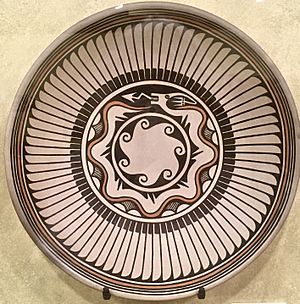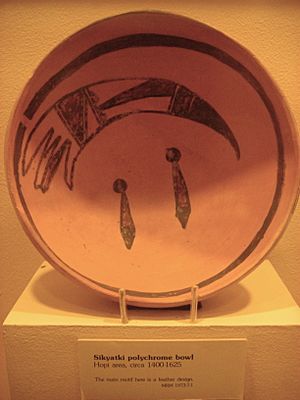Millicent Rogers Museum facts for kids


The Millicent Rogers Museum is a special art museum located in Taos, New Mexico. It was started in 1956 by the family of Millicent Rogers. The museum first displayed amazing art pieces collected by Millicent Rogers and her mother, Mary B. Rogers. They gave many early pieces of Taos Pueblo art. In the 1980s, this museum became the first big cultural place in New Mexico to show a wide range of Hispanic art.
Contents
Discover the Millicent Rogers Museum
A Look at Its Beginnings
Millicent Rogers was the granddaughter of one of the founders of Standard Oil. She was a very talented designer and supported the arts. In 1947, she moved to Taos, NM. Millicent loved to collect things. Her collection of Native American jewelry and weavings is very important. It shows a big part of Southwestern art and design.
Millicent Rogers passed away in 1952 in Taos, New Mexico, when she was 50 years old. The museum first opened in a temporary spot in the mid-1950s. In 1968, the museum moved to its permanent home. This building was originally a house built by Claude J. K. and Elizabeth Anderson in Taos. In the 1980s, a famous architect named Nathaniel A. Owings updated and made the museum bigger.
What You Can See: Museum Collections
The museum has a large collection of art from different cultures. You can find Native American, Hispanic, and Anglo-American art. It especially focuses on pieces from northern New Mexico and Taos, New Mexico.
The collection includes many interesting items:
- pottery, including very old and modern ceramics from the area. There is also a special collection of pottery by Maria Martinez.
- paintings.
- photography and graphics.
- arts and crafts.
- jewelry.
- Traditional and modern Hispanic religious and home arts. This includes furniture and textiles.
- Zuni and Hopi kachina figures.
Celebrating Different Cultures
Millicent's mother, Mary B. Rogers, helped a lot with the Pueblo Indian art. She gave many of these works to the museum. In the early 1980s, the museum started showing Hispanic art. It was the first big cultural group in New Mexico to do this. Millicent herself collected over 1,200 pieces of Native American and Hispanic jewelry. She also gathered more than 50 Native American and Hispanic textiles. These included Navajo chief blankets and colcha embroidery.
Native American Art and History
Millicent Rogers did more than just collect art. She also worked to protect Native American rights. In the mid-20th century, she used her social connections to help classify Native American art as "historic." This gave the art both protection and a higher status.
The museum's collection features baskets and pottery. Native Americans have been making and using these items for about 2,000 years.
Art from Taos Pueblo
The museum wants to help people understand Native American art better. It includes works from Taos Pueblo painters and potters. You can see examples of ancient micaceous clay pottery. There is also a large collection of works by 7th and 8th grade children. These pieces, called Oo-oonah, were made from 1968 to 1972.
Paintings by Pueblo artists like Albert Looking Elk (Martinez), Albert Lujan, and Juan Mirabal are in the museum. Works by Juanito Concha and other Pueblo artists are also shown. Many of these paintings on paper show the daily lives of people from the Southwest Pueblo tribes.
Zuni and Hopi Kachina Figures
The museum also has Zuni and Hopi kachina figures. These figures represent spiritual beings. Zuni kachinas are believed to live in remote northeastern Arizona. They are thought to bring life by giving rain and other support. For example, they might help hunters and farmers be successful. They can also influence people's good fortune or well-being.
Hispanic American Art and Culture
The collection includes traditional and modern Hispanic religious and home arts. This covers furniture and textiles. Santos are religious icons that started in the late 17th century. They are either painted on a flat board (called retablos) or carved from wood (called bultos).
Tinware was likely brought from Mexico and Spain. It was used for religious decorations and household items. These included sconces and mirrors. Tinware became very popular in the mid-19th century.
In 1993, the museum showed an exhibit called Light Forms: Jungle Rhythms. This was by Cuban-American artist Agnez Chavez.
Many Hispanic people needed to be self-sufficient. They used skills like woodworking, weaving, tinsmithing, farming, and leather work. They created furniture and furnishings for their homes. The museum has examples of these amazing crafts.
The Museum Store
The museum store offers multicultural artwork by talented local artists. You can find jewelry, ceramics, textiles, woodwork, graphics, and photography. The store also sells many books. These books cover subjects like the arts, architecture, literature, and the cultures of the Southwestern United States.
See also



